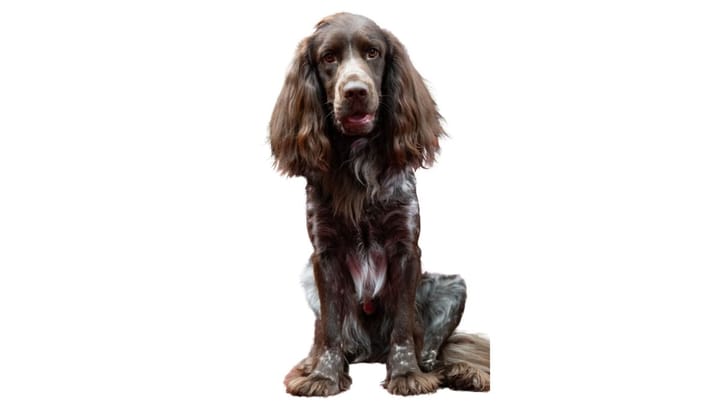Pont-Audemer Spaniel
Other names : Epagneul Pont-Audemer, Setter of Pont-Audemer

The Pont-Audemer Spaniel is a rare French gundog breed, which was developed in the 19th century after breeders mixed water spaniels and English Setters. Despite having many suitable qualities, they’re rarely kept as household pets. But these working dogs are loving, gentle, and really easy to train. They’re also very difficult to come by. Potential owners will need to find a specialist breeder.
|
Life expectancy |
The Pont-Audemer Spaniel has a life expectancy of between 12 and 14 years |
|
Temperament |
|
|
Size |
Medium
|
|
Adult size |
Female
Between 20 and 23 in
Male
Between 20 and 23 in
|
|
Adult weight |
Female
Between 37 and 44 lb
Male
Between 37 and 44 lb
|
|
Coat colour
Brown and white, brown and grey/heather, liver and white. |
Brown Blue |
|
Type of coat
Mid-length, curly and ruffled. Short and smooth around the face. |
Long |
|
Eye colour
Dark amber or hazel. |
Brown
|
They are very rare and you might have trouble finding one in the UK. Importing dogs can be a lengthy and very expensive process.
It’s really important to remember that these dogs are primarily working dogs. They might sometimes struggle with the “domesticated” life of the modern day dog.
More details about the Pont-Audemer Spaniel
Pont-Audemer Spaniel: Origins and history
The Pont-Audemer breed was developed in 19th century France. While it's exact origins are unknown, it's thought that English and French Water Spaniels, as well as English Setters, were thrown in the mix when creating this breed.
Although it never became as popular as some other gun dogs, the Pont-Audemer was still considered as a first-rate tracker and retriever. They specialised in retrieving water birds like wild ducks. They have a real enthusiasm for their work, and a playful nature.
They're also known as le petit clown des Marais, which translates as the little clown of the marshes.
Physical characteristics of the Pont-Audemer Spaniel
The Pont-Audemer Spaniel is a vigorous dog. She has a very unique wavy coat, but apart from that she looks very similar to more popular spaniel breeds such as the Springer. She has a long lean body, a high head carriage, and strong sturdy legs. Like most spaniels, they have long floppy ears and eyes filled with a gentle expression.
FCI classification of the Pont-Audemer Spaniel
-
Group 7 - Pointing Dogs
-
Section 1 : Continental Pointing Dogs
Pont-Audemer Spaniel: Characteristics
Pont-Audemer Spaniel: Behaviour
Training a Pont-Audemer Spaniel
This smart dog is naturally obedient and very easy to train. In fact, she has a real willingness to learn.
Pont-Audemer Spaniel: Lifestyle
Breed compatibility Pont-Audemer Spaniel
Pont-Audemer Spaniel: Purchase price
We do not have enough data to set an average price. Looking after a dog of this size typically costs between £70 to £100 a month, including food, medical/insurance, and incidental expenses.
Pont-Audemer Spaniel: Shedding
Light
Some younger pups can suffer from hair loss. It usually occurs between the first 7-18 months. Otherwise, shedding is moderate.
Pont-Audemer Spaniel: Grooming
Regular and weekly maintenance is necessary for this curly-haired dog. Her drooping ears that must be monitored in particular, and cleaned after each hunt.
Pont-Audemer Spaniel: Health
This a very healthy dog with an average life expectancy of 13 years.
This dog was bred to hunt and track game through the dense countryside, meaning she’s tough, durable, and extremely robust.
The Pont-Audemer is comfortable in warmer climates, although she shouldn't be exercised during the hottest part of the day. She loves running and the hot weather won’t stop her. This puts her at risk of overheating and heat exhaustion.
Although she only has a single-layered coat, it is waterproof. Pont-Audemers have no problems dealing with cold and wintery conditions.
This dynamic lady usually works out enough to stay in shape.
- Alopecia
- Hip Dysplasia
- Hypothyroidism
- Ear infections
- Hunting injuries

